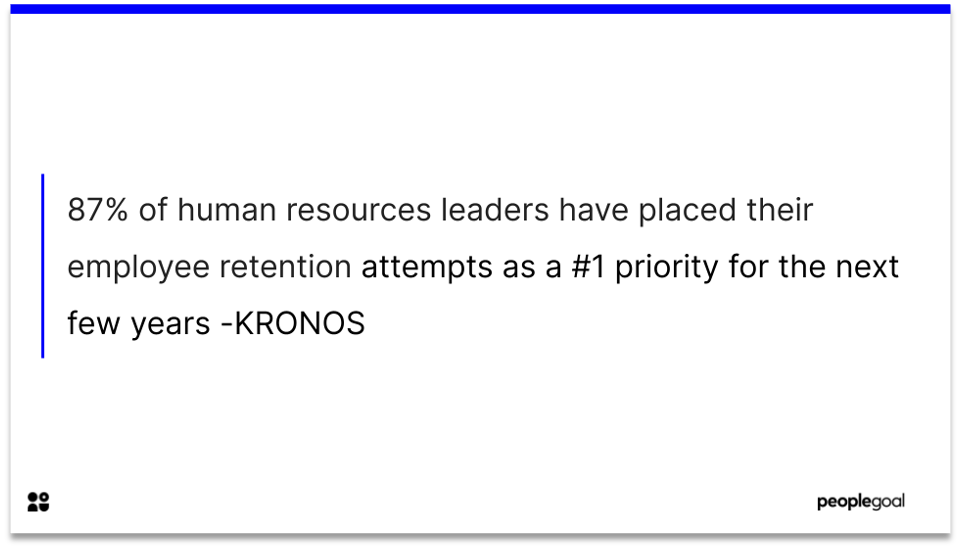Talent retention is becoming increasingly more difficult, with research showing 87% of human resources leaders have placed their employee retention attempts as a #1 priority for the next few years. While employees need to be able to develop new skills and be autonomous workers, employers need to develop successful strategies to engage and satisfy the needs of their employees in order to retain the best talent. Yet many companies continue to fail to do so. So what is the key? The answer might not surprise you; employee engagement surveys.

Take a look at the PeopleGoal Engagement app. It includes all the relevant workspaces to ensure your company maintains the necessary motivation, satisfaction, and commitment to your team’s engagement.
Technological development provides new ways of collecting and measuring data. AI algorithms that facilitate big data to measure employee engagement through email response times and network connections across organizations. Although as previously highlighted by the Harvard Business Review, there are multiple reasons why employee engagement surveys remain one of the most effective ways to measure and keep your talent engaged.

What is the purpose of employee engagement surveys?
- Track engagement levels and drivers of engagement
- Track whether your current strategy is working
- Show that employee feedback matters to your organization

You should also evaluate the objective is of the survey you are conducting. As discussed by digital HR tech it is important to determine what exactly you want to measure. Is it the happiness of your workforce? Their engagement? How empowered they feel, or how likely are they to recommend your organization? The survey should be always aligned with the business outcomes you want to accomplish and so should the engagement metrics you focus on.
We’ll pinpoint the best practices in employee surveys to enable you to make the most of your efforts and bring value to your company.
What are the best practices in employee engagement surveys?

1. Short surveys work better
The length of your survey can significantly affect the employee response rates. You should always remember that answering the survey is extra work for an employee, so respect their time and keep the survey concise and to the point. Aim to design a survey that takes 5-10 minutes to complete in order to maximize your response rates. As identified by a leader in survey software the longer it is the worse the results will be.
2. Avoid technical jargon
Sometimes it is easy to forget that the entire company is not familiar with HR jargon. You should avoid using technical terms in your surveys and use inclusive language everyone can easily understand. By doing so you will not only improve the survey results but also the experience of your employees; no one likes to be asked questions they do not understand.
3. Start and end with easy questions
Asking the easy questions first will make your employees more likely to fill out the survey. You want to make it feel like an easy job to them. Similarly, finishing with easy questions allows your respondents to ease out of the survey and remember it as a pleasant experience. You want to make them feel valued and appreciated by filling in the survey.
4. Aim each question at one topic only
Keeping the questions focused on one topic each will make the data analysis easier. It will also provide clearer results to you, which will make the strategy planning easier for you. Creating complex questions focused on the big picture might be tempting but what insights are you really going to gain?
5. Avoid open-ended questions
Unless you have a solid reason to ask open-ended questions avoid them. Especially if you are working for a large organization analyzing a high number of open-ended questions is going to make your life so much more difficult. It is also going to make the quality of the survey data poor as it is likely to be inconsistent and wordy.
If you really want to ask open-ended questions; limit it to one focused on your employees’ suggestions. That way, you separate the vital quantitative data and the ‘cherry on the top’ extra insights from your employees, which you can separate out in your analysis. Asking for suggestions will also show that you are interested in your employees’ opinions which have proved to have a positive impact on employee experience itself.
6. Remember the importance of design
User-centered design is essential for the success of an engagement survey. People do not usually fill out surveys because they love it, they are doing you a favor and thus you should make it as easy for them as possible. If the design of the survey is confusing and unclear no one will bother to fill it out.
7. Do not forget rewards and recognition
Lastly, ensure you thank your respondents for the time and effort they put into filling out the survey.
Engagement survey: Our final thoughts
To sum up, employee engagement matters, and it should matter to you. If you are still unsure how to create your first employee engagement survey read our guide to employee engagement surveys and make your company a great place to work.
Ready to 3x Your Teams' Performance?
Use the best performance management software to align goals, track progress, and boost employee engagement.






